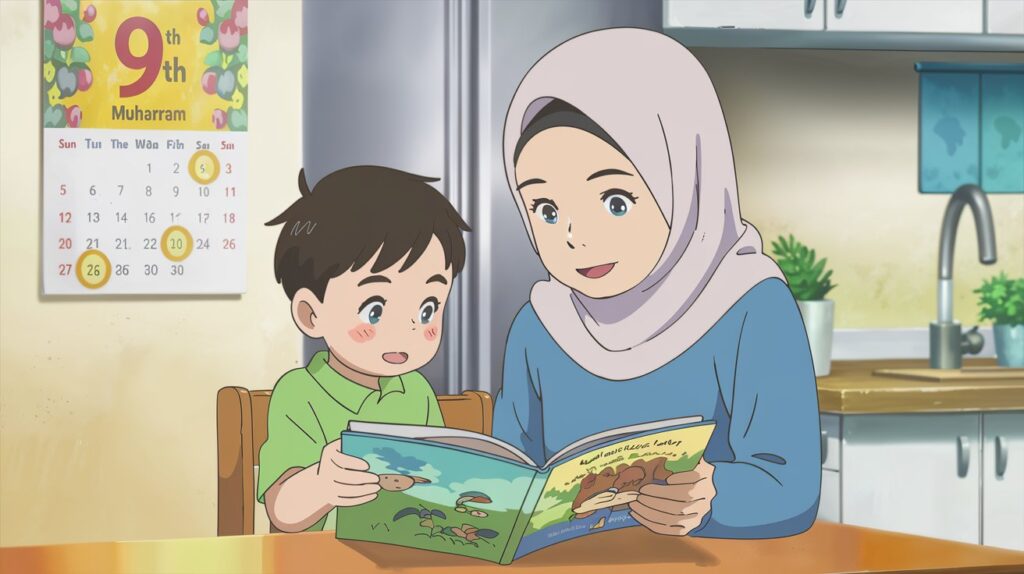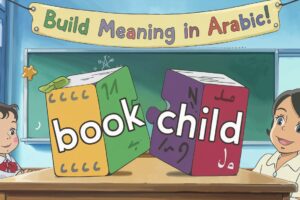
Arabic for children: Teaching Arabic from Zero at Home 🏡
Introduction:
“I want my child to understand the Qur’an… but I don’t even know the Arabic alphabet.”
Sound familiar? You’re not alone.
For many English-speaking Muslim families, introducing Arabic for children feels overwhelming. But here’s the good news: you don’t need to be fluent to start. With the right steps, you can build a strong Arabic foundation at home—even if your child has zero background and you’re learning together.
In this guide, you’ll discover how to teach Arabic to children using short, consistent routines, interactive visuals, and Qur’anic vocabulary—all while keeping the process fun and pressure-free.

📌 Step 1: Why Arabic for Children Starts with Sound and Meaning
Children are natural mimics. So before focusing on rules or writing, begin with Arabic sounds—just like you did with English.
🎧 What to Do:
- Play slow, clear Arabic recitation daily — Surah Al-Fatihah is a great place to start.
- Use flashcards with audio buttons (or free apps like Learn Arabic for Kids).
- Say letter sounds out loud: Alif… Baa… Taa… — focus on how it sounds, not how it looks.
🔁 Keep it short and repetitive—just 3–5 minutes a day.
📌 Step 2: Use Visuals and Stories to Teach Letters
Kids remember what they see and feel. Arabic letters can become fun characters with shapes, animals, or objects.
🧠 Example:
- ب (Baa) looks like a boat with one button = B for Button
- ت (Taa) has two dots = T for Two
- ث (Thaa) has three = T for Three
🎨 Download or create an Arabic alphabet poster with illustrations your child will connect with. Place it somewhere visible—like on the fridge or bedroom wall.
📌 Step 3: Make it a Game, Not a Chore
💡 The key to engagement? Turn learning into playtime. Use matching games, Arabic bingo, or our favorite at Roots:
🔤 “Find the Letter” scavenger hunt:
- Call out a letter sound
- Your child runs to tap it on the poster
- Or they color it in a coloring sheet
🎲 Add stickers, rewards, and high fives for each win—it creates positive associations with Arabic.
📌 Step 4: Introduce Meaning with Quranic Words
Even before grammar, children can learn powerful Arabic words from the Qur’an. Start with:
- نُور (Noor) – light
- سَلام (Salaam) – peace
- قَلْب (Qalb) – heart
- رَحْمَة (Rahmah) – mercy
📖 Use these in simple sentences:
“Can you find the word Noor in this verse?”
“Let’s say ‘Salaam’ to each other in Arabic!”
🧠 Connecting Arabic to real meaning helps it stick—and nurtures a love for the Qur’an early on.

📌 Step 5: Build a Daily 5-Minute Arabic Routine
✅ Keep it short.
✅ Keep it visual.
✅ Keep it joyful.
Here’s a simple daily structure:
- Play 1 Quran recitation
- Review 1 letter sound
- Trace or color that letter
- Say 1 Arabic word together
- Celebrate effort, not perfection!
🎁 Bonus Tip: Use a sticker chart or Arabic “passport” to track your child’s progress!
Final Thought: You’re Planting Seeds for a Lifetime 🌱
You don’t have to master Arabic overnight. What matters most is showing your child that Arabic is part of your family’s heart and home. Even five minutes of joyful, consistent effort can unlock a lifetime of Qur’anic connection.
At Roots Muslim School, we help families like yours every day. Our Arabic programs are designed specifically for English-speaking kids—with stories, games, and real understanding.
🎉 Ready to make Arabic part of your home? Let’s grow together.



